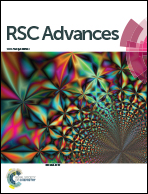Increasing power density and dye decolorization of an X-3B-fed microbial fuel cell via TiO2 photocatalysis pretreatment†
Abstract
To improve the output power density of dye-fed microbial fuel cells (MFCs), which decreases with increasing dye concentration, a new strategy involving TiO2 photocatalysis pretreatment of high content dye wastewater was proposed and demonstrated in this study. 200 mg L−1 X-3B wastewater was treated using F-doped nano-TiO2 under visible light for 2.5 h and then mixed into the substrate, and the maximum output power density (PM) of MFC reached 392 mW m−2. As a comparison, PM was only 276 mW m−2 when untreated X-3B wastewater was used as the substrate. About 42% power density was retrieved from the MFC fed with high concentration X-3B wastewater via prior photocatalytic treatment. Moreover, the decolorization rate of X-3B was also enhanced from 42% to 56.5% when combined with the photocatalysis process. The increase of power density after photocatalysis of X-3B was attributed to less electron consumption by decomposed X-3B, extra electron donors and mediators from produced intermediates as well as increased bacterial diversity in the anode chamber. These results demonstrated TiO2 photocatalysis pretreatment as an effective and easy to implement technology for improving both the electricity harvest and pollutant elimination from wastewaters that contain concentrated hard-to-use biomass without specially acclimatizing or modifying MFC.


 Please wait while we load your content...
Please wait while we load your content...